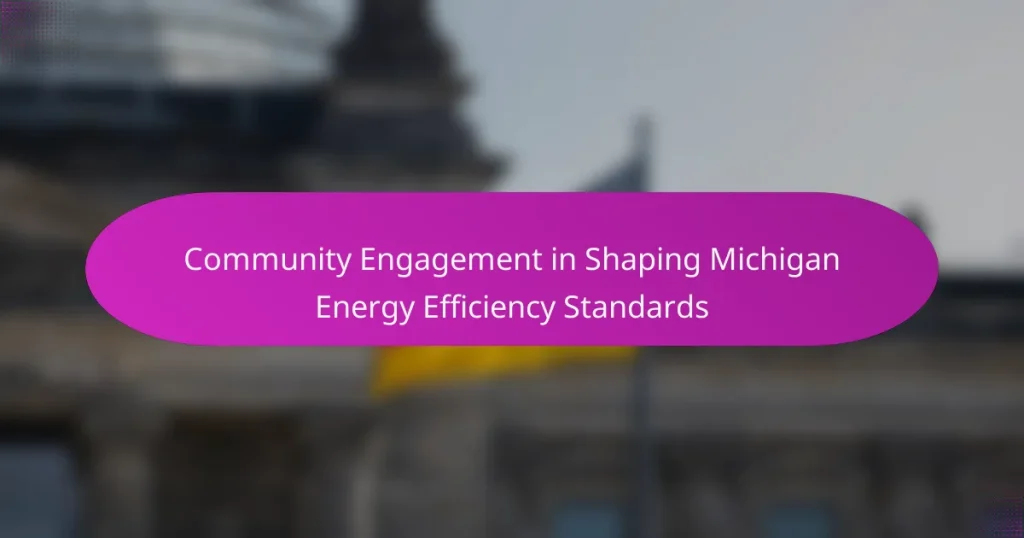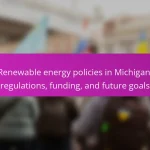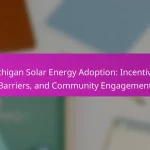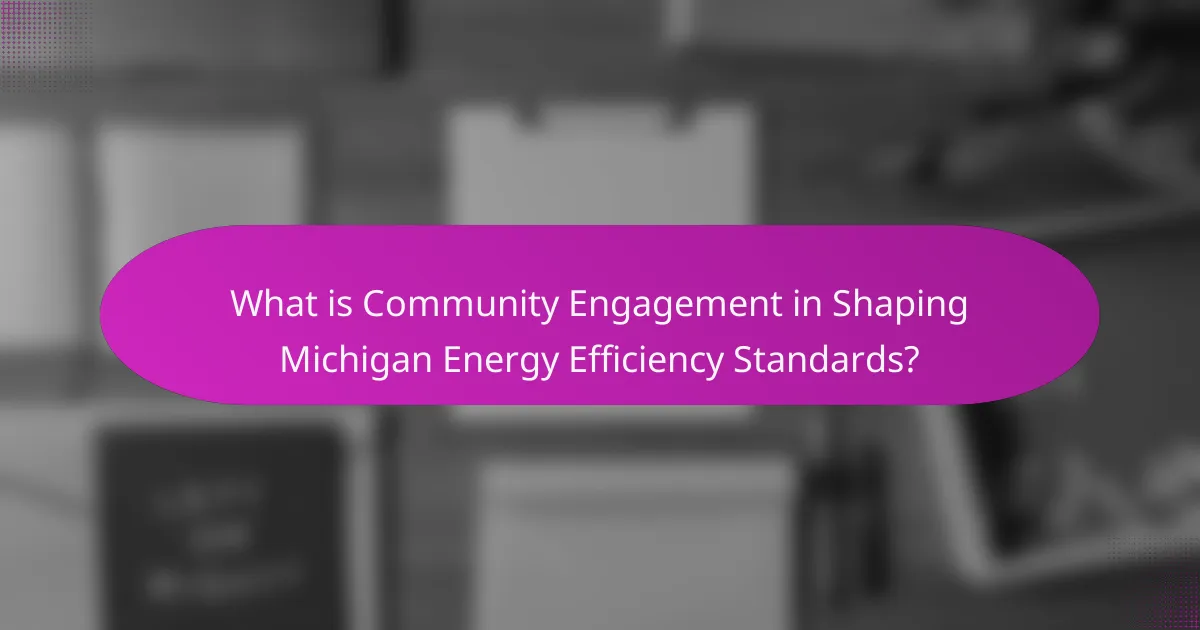
What is Community Engagement in Shaping Michigan Energy Efficiency Standards?
Community engagement in shaping Michigan energy efficiency standards refers to the involvement of local communities in the development and implementation of energy policies. This process allows residents, businesses, and organizations to provide input on energy efficiency measures that affect their lives. Engaging the community ensures that standards reflect the needs and priorities of diverse stakeholders. It fosters collaboration between government agencies, utilities, and citizens. This approach can lead to more effective and equitable energy solutions. Research shows that community input can enhance the acceptance and success of energy efficiency programs. By incorporating local knowledge and experiences, policymakers can create standards that are both practical and beneficial.
How does community engagement influence energy efficiency standards in Michigan?
Community engagement significantly influences energy efficiency standards in Michigan. Engaged communities advocate for policies that reflect local needs and priorities. Public input can shape regulations and initiatives aimed at improving energy efficiency. For example, community feedback has led to the adoption of more stringent energy codes in various municipalities. Collaborative efforts between local governments and residents enhance awareness of energy-saving practices. Studies show that areas with active community involvement often see higher compliance with energy efficiency measures. Additionally, community engagement fosters partnerships that can provide resources for implementing energy-efficient technologies.
What are the key components of community engagement in this context?
Key components of community engagement in shaping Michigan energy efficiency standards include collaboration, communication, and inclusivity. Collaboration involves stakeholders working together to share insights and resources. Communication ensures transparency and fosters trust among participants. Inclusivity means actively involving diverse community members in the decision-making process. These components help create a more effective and representative energy efficiency framework. Research shows that effective community engagement leads to better policy outcomes and increased public support for energy initiatives.
How does community input impact policy decisions regarding energy efficiency?
Community input significantly influences policy decisions regarding energy efficiency. Local feedback helps identify specific needs and priorities within communities. Policymakers can use this information to create tailored energy efficiency programs. Engaging the community fosters trust and transparency in the decision-making process. Studies show that when communities are involved, energy efficiency initiatives are more likely to succeed. For example, programs designed with community input have reported higher participation rates. This approach also ensures that policies reflect the values and concerns of the population. Ultimately, community input leads to more effective and sustainable energy efficiency policies.
Why is community engagement essential for effective energy efficiency standards?
Community engagement is essential for effective energy efficiency standards because it fosters collaboration and ensures that diverse perspectives are considered. Engaging communities helps identify local needs and barriers to energy efficiency. This input can lead to more tailored and relevant standards that reflect the specific circumstances of different regions. Research shows that programs with community involvement achieve higher participation rates and greater energy savings. For instance, the American Council for an Energy-Efficient Economy reported that community-based programs can result in energy savings increases of up to 30%. By involving stakeholders, energy efficiency standards become more accepted and successful in implementation.
What benefits does community engagement bring to energy policy development?
Community engagement enhances energy policy development by incorporating diverse perspectives. It fosters transparency and builds trust between policymakers and the community. Engaged communities are more likely to support energy initiatives. This support can lead to smoother implementation of policies. Community input can identify local needs and priorities. Tailoring policies to these needs increases their effectiveness. Research shows that inclusive policy processes result in better outcomes. A study by the National Renewable Energy Laboratory found that community involvement improves energy efficiency program participation rates.
How does community involvement enhance the implementation of energy efficiency measures?
Community involvement enhances the implementation of energy efficiency measures by fostering local support and participation. Engaged communities are more likely to adopt energy-saving practices. They provide valuable insights into local needs and barriers. This feedback helps tailor programs to be more effective. Community members can also act as advocates, promoting energy efficiency initiatives. Their involvement can lead to increased funding opportunities through local partnerships. Studies show that community-based programs achieve higher participation rates. For example, a report from the American Council for an Energy-Efficient Economy highlights that community engagement can double participation in energy efficiency programs.
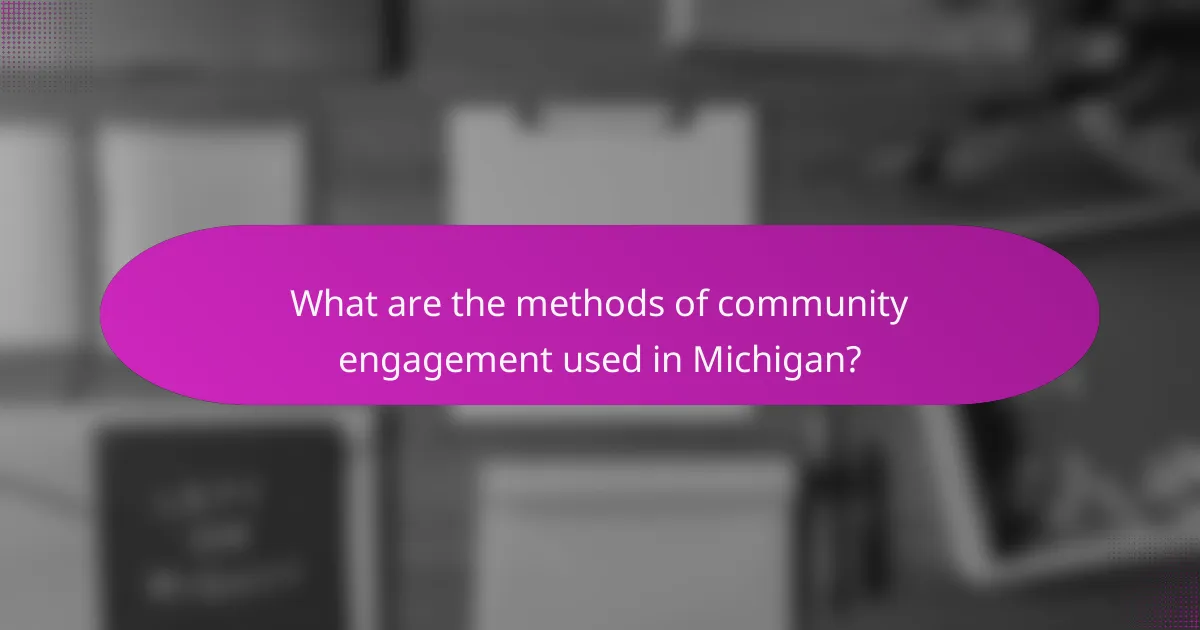
What are the methods of community engagement used in Michigan?
Community engagement methods used in Michigan include public meetings, surveys, and stakeholder workshops. Public meetings allow residents to voice their opinions and concerns. Surveys gather quantitative data on community preferences and priorities. Stakeholder workshops facilitate in-depth discussions among various interest groups. These methods ensure diverse community input into energy efficiency standards. The Michigan Public Service Commission reports that these engagement strategies enhance transparency and accountability in decision-making processes.
How do public forums contribute to shaping energy efficiency standards?
Public forums contribute to shaping energy efficiency standards by facilitating community input and discussion. They provide a platform for stakeholders to express concerns and suggestions regarding energy policies. This engagement helps policymakers understand public priorities and preferences. Research indicates that community feedback can lead to more effective and widely accepted standards. For instance, the Michigan Public Service Commission often incorporates insights from public forums into regulatory decisions. This process ensures that energy efficiency standards reflect the needs and values of the community. Ultimately, public forums enhance transparency and foster collaboration between citizens and regulators.
What types of feedback are typically gathered during public forums?
Public forums typically gather stakeholder opinions, community concerns, and suggestions for improvement. Feedback often includes preferences regarding energy efficiency initiatives. Participants may express their views on proposed policies and programs. Data collected can also include demographic information of attendees. Additionally, forums may capture insights on barriers to energy efficiency adoption. Surveys and comment forms are common tools for gathering this feedback. Engaging with community members in this way helps shape effective energy policies.
How effective are public forums in representing diverse community voices?
Public forums are effective in representing diverse community voices by facilitating open dialogue and participation. They provide a platform for individuals from various backgrounds to share their perspectives. Research shows that inclusive public forums can lead to better decision-making outcomes. For instance, the National Coalition for Dialogue & Deliberation highlights that diverse input enhances the quality of community engagement. Furthermore, studies indicate that communities with active public forums report higher satisfaction with local governance. This effectiveness is crucial in shaping policies, such as Michigan’s energy efficiency standards, to reflect the needs of all stakeholders.
What role do surveys play in community engagement for energy standards?
Surveys play a crucial role in community engagement for energy standards. They gather valuable feedback from residents regarding their energy needs and preferences. This feedback helps policymakers understand community priorities. Surveys can identify barriers to adopting energy-efficient practices. They also assess public awareness of existing energy standards. By incorporating survey results, energy programs can be tailored to better meet community expectations. Data from surveys can enhance transparency in decision-making processes. Ultimately, surveys foster a sense of ownership among community members regarding energy efficiency initiatives.
What are the common topics addressed in surveys related to energy efficiency?
Common topics addressed in surveys related to energy efficiency include consumer awareness, energy consumption habits, and attitudes towards energy-saving measures. Surveys often explore the effectiveness of energy efficiency programs. They assess barriers to participation in these programs. Additionally, they evaluate the perceived benefits of energy efficiency improvements. Surveys may also investigate the role of incentives in promoting energy-efficient practices. Furthermore, they examine demographic factors influencing energy efficiency behaviors. These topics provide insights into public perceptions and behaviors regarding energy efficiency initiatives.
How can survey results influence policy changes?
Survey results can significantly influence policy changes by providing data-driven insights into community needs and preferences. Policymakers often rely on surveys to gauge public opinion and identify priority areas for intervention. For instance, surveys can reveal widespread support for specific energy efficiency measures among residents. This feedback can lead to the adoption of policies that align with community values and expectations. In Michigan, survey results have been used to shape energy efficiency standards, ensuring they reflect the priorities of the population. Evidence from the Michigan Public Service Commission indicates that community input through surveys has led to more effective and accepted energy policies.
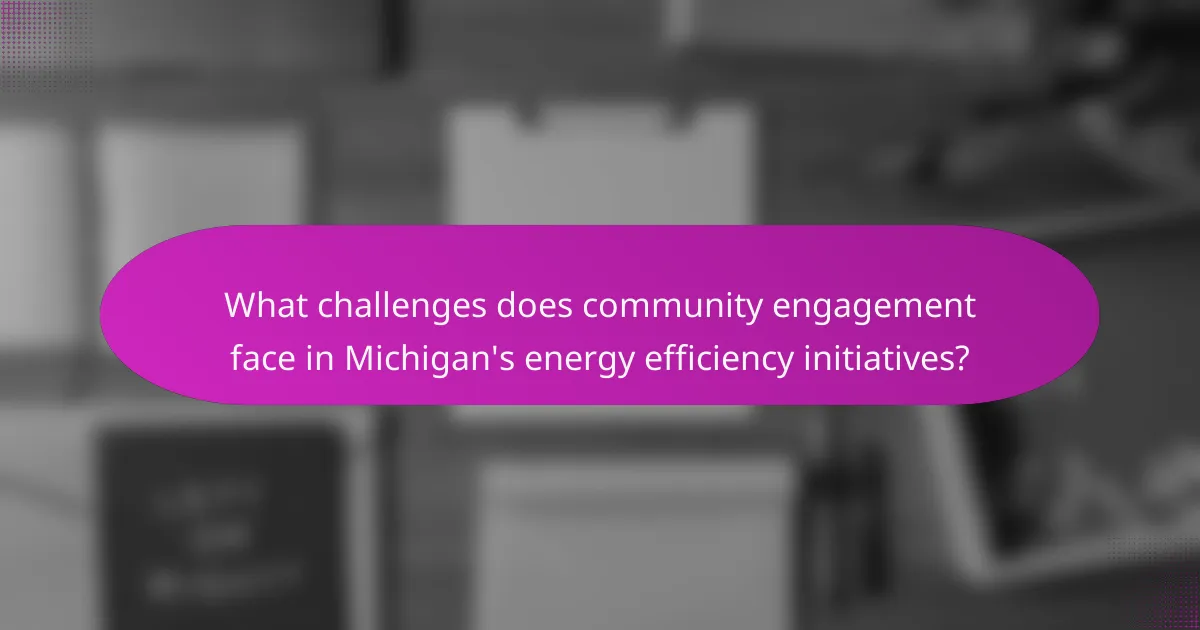
What challenges does community engagement face in Michigan’s energy efficiency initiatives?
Community engagement in Michigan’s energy efficiency initiatives faces several challenges. One significant challenge is the lack of awareness among residents about energy efficiency programs. Many community members are unaware of available resources and benefits. This can lead to low participation rates in energy-saving initiatives. Additionally, socioeconomic factors create barriers to engagement. Low-income households may prioritize immediate financial needs over energy efficiency investments. Cultural differences can also impact communication and outreach efforts. Misunderstandings may arise if information is not tailored to diverse communities. Furthermore, trust in government and utility companies can be low. Past experiences may lead to skepticism about the effectiveness of programs. These challenges hinder the overall success of energy efficiency initiatives in Michigan.
How do socio-economic factors affect community participation?
Socio-economic factors significantly influence community participation. Individuals from higher socio-economic backgrounds often have more resources and time to engage in community activities. They may also have better access to information about community initiatives. Conversely, those from lower socio-economic backgrounds may face barriers such as financial constraints and lack of transportation. Studies show that communities with diverse socio-economic status tend to have more varied participation levels. For example, research indicates that neighborhoods with higher income levels experience greater involvement in local governance. Additionally, educational attainment, which correlates with socio-economic status, impacts individuals’ ability to participate effectively. Therefore, addressing these socio-economic disparities is crucial for enhancing community engagement.
What barriers exist for underrepresented communities in engaging with energy policies?
Underrepresented communities face several barriers in engaging with energy policies. These barriers include lack of access to information about energy policies. Many community members may not be aware of existing programs or how to participate. Language barriers can also hinder engagement for non-English speakers. Limited financial resources restrict participation in policy discussions and forums. Additionally, these communities often experience systemic disenfranchisement, leading to a lack of trust in governmental institutions. Research indicates that only 30% of low-income households feel adequately informed about energy efficiency programs. Furthermore, geographical isolation can limit access to meetings or events focused on energy policy. These factors collectively create significant obstacles for underrepresented communities in engaging with energy policies.
How can these barriers be addressed to improve participation?
Barriers to participation can be addressed by implementing targeted outreach strategies. These strategies should focus on educating community members about energy efficiency standards. Providing clear information can demystify the process and encourage involvement. Additionally, creating accessible forums for discussion can facilitate dialogue between stakeholders.
Engagement efforts should include diverse communication channels, such as social media, workshops, and community meetings. This ensures that all voices are heard and valued. Collaborating with local organizations can also enhance trust and credibility.
Research indicates that inclusive practices significantly increase participation rates. For example, a study by the American Council for an Energy-Efficient Economy found that targeted outreach led to a 30% increase in community engagement. Therefore, addressing barriers with these strategies can effectively improve participation in shaping Michigan’s energy efficiency standards.
What strategies can enhance community engagement in energy efficiency standards?
Community engagement in energy efficiency standards can be enhanced through targeted outreach, education, and collaboration. Effective communication strategies inform residents about the benefits of energy efficiency. Workshops and seminars can provide hands-on learning experiences. Utilizing social media platforms increases awareness and participation. Partnerships with local organizations foster trust and credibility. Incentive programs encourage community members to adopt energy-saving practices. Surveys and feedback mechanisms allow residents to voice their opinions and needs. Research shows that communities engaged in energy efficiency initiatives see a 20% increase in participation rates.
What best practices can be adopted for more effective community outreach?
Effective community outreach can be achieved through several best practices. First, establish clear communication channels with the community. Utilize social media, newsletters, and local events to disseminate information. Second, engage community leaders and stakeholders early in the process. Their support can enhance credibility and outreach effectiveness. Third, tailor messages to resonate with the specific interests and needs of the community. This personalization fosters a stronger connection. Fourth, provide opportunities for community input and feedback. Surveys and town hall meetings can facilitate this engagement. Fifth, ensure transparency in the outreach process. Sharing goals, progress, and challenges builds trust with the community. Lastly, evaluate outreach efforts regularly. Collect data on participation and feedback to refine strategies. These practices are supported by community engagement research, which shows that effective outreach leads to increased participation and better outcomes in initiatives.
What are the next steps for improving community engagement in Michigan?
Enhancing community engagement in Michigan requires strategic initiatives. First, local governments should host regular town hall meetings. These meetings can facilitate direct dialogue between citizens and policymakers. Second, implementing online platforms for feedback can increase participation. Surveys and forums can gather diverse community opinions efficiently. Third, educational workshops on energy efficiency can empower residents. Knowledgeable citizens are more likely to engage in discussions. Fourth, partnerships with community organizations can broaden outreach efforts. Collaborating with local groups can help identify specific community needs. Lastly, transparency in decision-making processes fosters trust. Clear communication about how community input shapes policies is essential. These steps align with successful engagement strategies observed in other states.
Community engagement in shaping Michigan energy efficiency standards involves the active participation of local communities in the development and implementation of energy policies. The article outlines how community input influences energy efficiency standards, highlighting key components such as collaboration, communication, and inclusivity. It discusses various methods of engagement, including public forums and surveys, and addresses challenges faced by underrepresented communities in participating. The article emphasizes the importance of targeted outreach strategies and best practices for enhancing community engagement to ensure that energy efficiency policies reflect the needs and priorities of diverse stakeholders.
